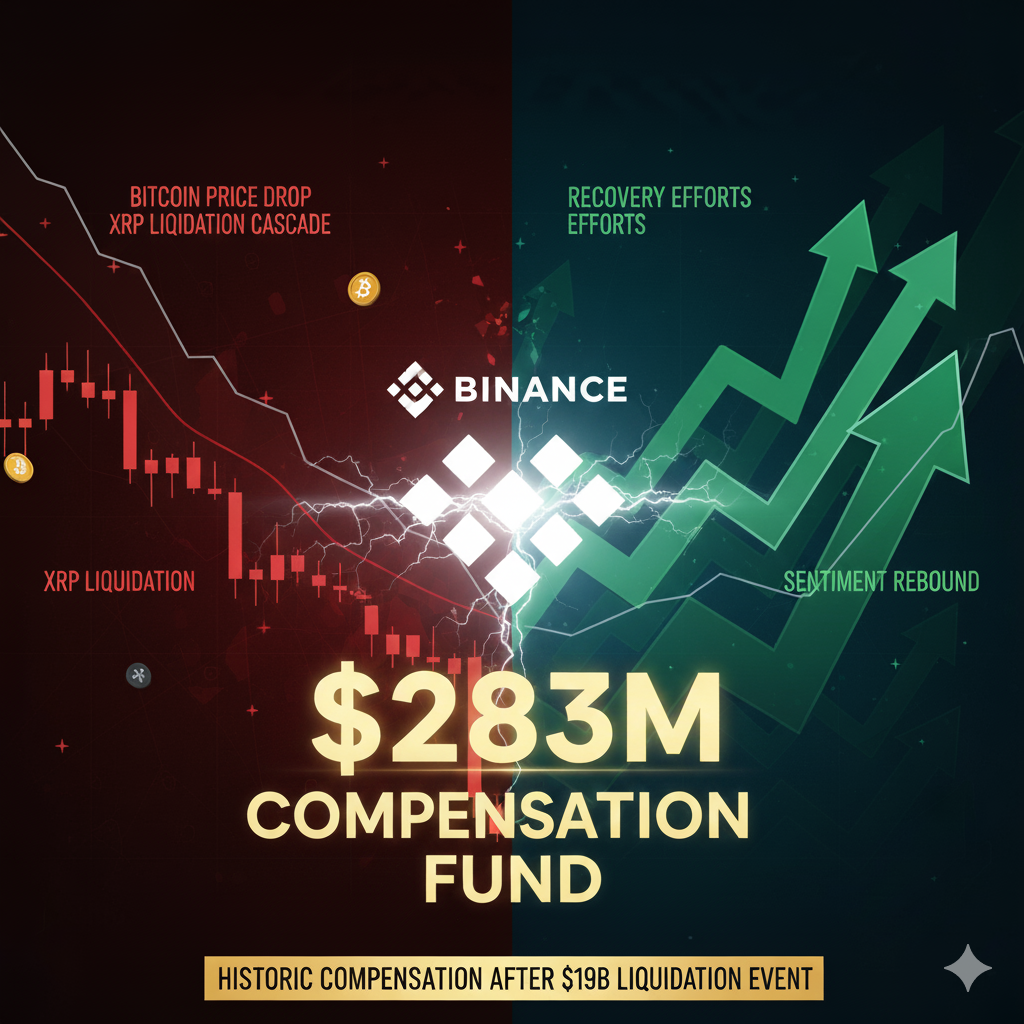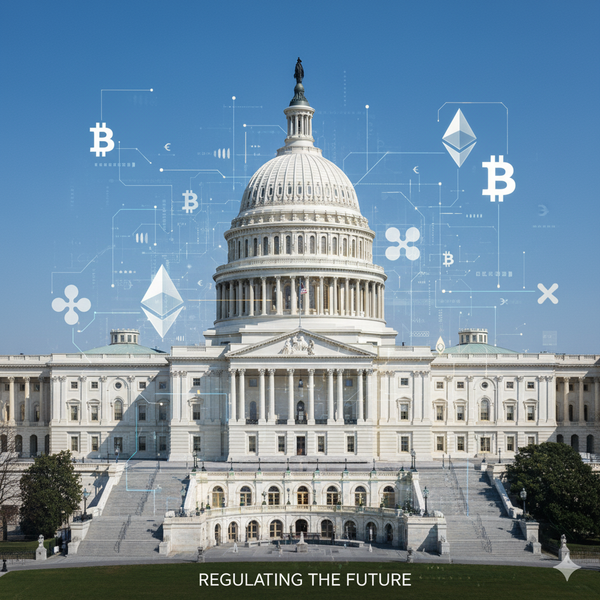Binance Distributes $283M After Largest Crypto Liquidation Event in History
Binance distributes $283M to users after October 10's historic $19B crypto liquidation event. XRP crashed 56% with $707M in losses before swift recovery. The largest compensation program in crypto history addresses platform issues during market chaos. #Crypto #Binance #XRP

In an unprecedented move following the most catastrophic liquidation event in cryptocurrency history, Binance has confirmed the distribution of $283 million in compensation to users who suffered losses during the October 10, 2025 market crash. The exchange acted swiftly to address platform-related issues that coincided with a brutal market downturn triggered by geopolitical tensions.
The Perfect Storm: When Markets Collapsed
October 10, 2025, will be remembered as one of the darkest days in crypto history. The market experienced a violent cascade of liquidations totaling over $19 billion across all exchanges within 24 hours, affecting approximately 1.7 million traders globally. This staggering figure eclipses previous catastrophic events including the Terra Luna collapse and the FTX implosion.
The catalyst for this unprecedented volatility was President Donald Trump's announcement of 100% tariffs on Chinese imports, coming in response to China's planned export restrictions on rare earth minerals. This geopolitical shock sent tremors through both traditional and crypto markets, triggering panic selling across all risk assets. Bitcoin plummeted from around $122,500 to below $110,000, while Ethereum dropped beneath $3,700 as fear gripped the market.
Binance's Technical Challenges and Token Depegging
While the broader market crash affected all exchanges, Binance users faced an additional crisis as three key assets used as collateral experienced severe depegging events. Between 21:36 and 22:16 UTC on October 10, the situation spiraled out of control.
Ethena's USDe stablecoin, designed to maintain a 1:1 peg with the US dollar, crashed to as low as $0.66 on Binance despite maintaining its peg on other exchanges. BNSOL, Binance's Solana liquid staking token, plummeted from approximately $300 to $34.90. WBETH (Wrapped Beacon ETH) depegged to $430, representing an 88% discount from Ethereum's spot price of over $3,800.
These dramatic price dislocations were exacerbated by what Binance described as rapid evaporation of liquidity, with order books becoming "hollow" as support vanished. The exchange also experienced degraded performance during the surge in trading activity, causing transaction errors and order delays that prevented some users from exiting positions before being liquidated.
Binance Co-Founder and Chief Customer Service Officer Yi He publicly acknowledged the exchange's shortcomings: "Due to significant market fluctuations over the past 16 hours and a substantial influx of users, some users have encountered issues with their transactions. I deeply apologize for this."
Compensation Structure and Eligibility
The $283 million compensation program, distributed in two batches within 24-72 hours, represents Binance's largest-ever user reimbursement. The exchange confirmed that compensation covers Futures, Margin, and Loan users who held USDe, BNSOL, or WBETH as collateral during the critical depegging window.
The compensation amount equals the difference between the market price at midnight UTC on October 11 and each user's liquidation price. Importantly, Binance clarified that only losses directly attributable to platform technical failures qualify for reimbursement. Losses from normal market movements and unrealized profits are not covered.
In a notable decision that earned praise from the community, Yi He confirmed that users who managed to acquire depegged tokens at bargain prices during the chaos would be allowed to keep them. "Those who acquired depegged assets at low prices yesterday earned them by staying up late, and we will not reclaim those," she stated.
Binance CEO Richard Teng reinforced the exchange's commitment to transparency: "We don't make excuses—we listen closely, learn from what happened, and are committed to doing better."
Market-Wide Implications and Regulatory Scrutiny
The sheer scale of this event has sparked intense debate about exchange stability and risk management across the industry. Crypto.com CEO Kris Marszalek called for regulatory oversight, stating: "Regulators should look into the exchanges that had most liquidations in the last 24h and conduct a thorough review of fairness of practices. $20B in liquidations, a lot of users got hurt."
Some analysts have suggested the event may have been a targeted exploit, pointing to Binance's Unified Account system which allows traders to use multiple types of collateral. When tokens depegged, collateral values collapsed, triggering automatic liquidations across thousands of accounts simultaneously.
Interestingly, decentralized finance (DeFi) platforms demonstrated remarkable resilience during the crisis. Uniswap processed $10 billion in daily volume without issues, while lending protocol Aave completed $180 million in collateral liquidations smoothly with no system failures. This stark contrast has amplified calls for greater adoption of decentralized alternatives.
Binance has announced several risk control enhancements to prevent future disruptions, including adding redemption prices to the BNSOL, WBETH, and USDe price index weights, setting minimum price thresholds, and increasing the frequency of risk parameter reviews.
XRP/Ripple: Caught in the Crossfire
XRP holders experienced one of the most violent trading sessions in the asset's history during the October 10 crash. The token plummeted as much as 56% from $2.83 to an astonishing low of $1.25 on some exchanges, with over $707 million in XRP positions liquidated according to CoinGlass data. Community analyst Chad Steingraber labeled the event an "XRP Black Swan," emphasizing the unprecedented scale of liquidations.
CoinDesk reported that XRP's price action included a brief touch of $1.64 before a partial recovery to $2.36, with trading volumes surging 164% above the 30-day average—a clear sign of forced deleveraging across institutional desks. Institutional futures open interest decreased by $150 million, highlighting the severity of long liquidations. More than $600 million of the total XRP liquidations came from long positions as leveraged traders betting on continued price appreciation were caught off guard.
The crash was amplified by several XRP-specific factors beyond the broader market conditions. Whale activity played a significant role, with 320 million XRP moved to exchange wallets in the week leading up to the crash, indicating distribution pressure from large holders looking to exit positions. Additionally, the October 7 deadline for Ripple's National Trust charter application had passed, adding regulatory uncertainty that contributed to reduced institutional involvement in XRP markets.
XRP's Remarkable Recovery and Future Outlook
Despite the brutal selloff, XRP demonstrated unexpected resilience. The token staged a swift V-shaped recovery back to the $2.40 range within hours, with observers attributing the bounce to large buyers absorbing panic selling. Market analyst Zaheer Ebtikar of Split Capital noted that while the initial crash involved widespread liquidation orders flooding exchanges, XRP's ability to quickly stabilize suggested underlying demand remained strong.
Several positive catalysts continue to support XRP's longer-term prospects despite this short-term volatility. Polymarket data shows 96% odds favoring XRP spot ETF approval by October 2025, which could provide a significant boost to institutional adoption. The first US-listed spot XRP ETF launched in September 2025 following the favorable ruling in the SEC vs. Ripple case, which determined that XRP sold on public exchanges is not a security.
Ripple's continued expansion of its On-Demand Liquidity (ODL) service and the XRP Ledger's growing role in decentralized finance present substantial growth opportunities. Analysts project XRP could trade between $2.34 and $2.85 in the near term, with potential to reach $3.30-$3.50 if bullish momentum holds. Long-term models forecast XRP reaching $2.97 in 2026, $3.11 in 2027, and $3.61 by 2030, aligning with projected adoption by banks and financial institutions for cross-border payments.
However, traders remain cautious. The key technical level to watch is $2.50, which has flipped from support to resistance. Bulls need to reclaim this level to invalidate the short-term bearish bias and potentially target the $2.90-$3.05 resistance zone. On-chain data indicates that long-term holders remained active during the crash, adding to their positions below $2.40, suggesting confidence in XRP's value proposition despite the volatility.
Implications for Ripple's Business and Legal Standing
The crash and subsequent recovery have broader implications for Ripple Labs. The company's legal clarity following the SEC settlement has positioned XRP as a potentially "de-risked" asset in the eyes of institutions, which likely contributed to the swift recovery. The ongoing development of XRP-based financial products, including ETFs and institutional custody solutions, suggests that major financial players view the October 10 event as a temporary liquidity crisis rather than a fundamental problem with XRP's utility.
Ripple's partnerships with financial institutions for cross-border payment solutions continue to expand, with the ODL service processing increasing volumes despite market volatility. The company's focus on regulatory compliance and working within existing financial frameworks has positioned it favorably as clarity emerges in the cryptocurrency regulatory landscape.
Key Takeaways
The October 10, 2025 market crash serves as a stark reminder of the inherent volatility in cryptocurrency markets and the critical importance of robust risk management systems. Binance's $283 million compensation demonstrates accountability but also exposes vulnerabilities in centralized exchange infrastructure during extreme stress.
For investors, this event underscores several crucial lessons: the dangers of excessive leverage, the importance of platform diversification, the value of self-custody solutions, and the need to understand how exchanges manage collateral during market stress. XRP's dramatic crash and recovery highlight both the risks and opportunities present in volatile markets, while also demonstrating the token's resilience and the strength of its long-term holder base.
As the market continues to mature, events like this will likely drive improvements in exchange architecture, more sophisticated risk controls, and potentially accelerate the shift toward decentralized trading infrastructure that proved remarkably stable during this crisis.
DISCLAIMER: This newsletter is for informational purposes only and does not constitute investment advice, advertising, or a recommendation to buy, sell, or hold any securities. This content is not sponsored by or affiliated with any of the mentioned entities. Investments in cryptocurrencies or other financial assets carry significant risks, including the potential for total loss, extreme volatility, and regulatory uncertainty. Past performance is not indicative of future results. Always consult a qualified financial professional and conduct thorough research before making any investment decisions.
Sources
- Crypto Briefing - Leveraged Positions Liquidation
- Financial Content Markets - Binance Reimburses $283M
- CryptoPotato - Binance Explains Market Crash
- The Block - Binance Pays $283M in Compensation
- CoinDesk - XRP Price Analysis
- AIInvest - XRP Black Swan Crash
- BeInCrypto - XRP Liquidation Analysis
- CoinDesk - Bitcoin Crashes on Trump Tariff
- Bitcoin Ethereum News - Binance Compensation Announcement
- CoinCentral - XRP Major Drop Analysis



